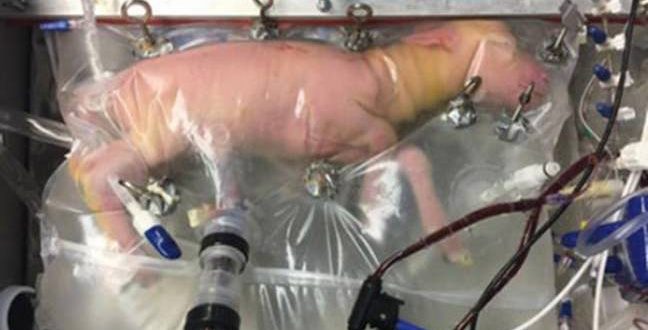Researchers have managed to keep prematurely born baby sheep alive for four weeks in an “artificial womb” known as a “biobag.”
The womb-like environment stimulates prenatal fluid, giving extremely premature babies more time to develop their lungs and other organs, while reducing their chance for death or disability.
A team of pediatric scientists developed the system that uses a fluid-filled container attached to custom-designed machines that provide physiological support with the aim of supporting infants from 23 weeks to 28 weeks’ gestational age where they cross the threshold away from the most severe outcomes of extreme premature birth.
Babies born as early as 22 weeks have a 50 percent chance of survival with current technology, but the same devices that save their lives can cause problems that last well into adulthood.
“We know that even a few hours of that [current technology] damages the lungs of a 24-week infant,” says Dr. George Mychaliska, a pediatric and fetal surgeon at C.S. Mott Children’s Hospital. “Our hands are tied, because in the absence of that, the baby would die. So we accept some lung damage to keep the baby alive.”
With this new technology, doctors hope for a much greater chance of survival without developmental problems. While tests have not started on humans as of yet, Mychaliska has tested the technology on prematurely born lambs. “The duration of support is outstanding,” he said.
Scientists predict that human testing is at least three years away, but the technology will face its own problems. Umbilical chords shrink the moment they are hit by air, Stat reported, making it difficult to fit tubes into them. Stat also noted that the artificial uteri can easily be contaminated with infections, and the fetal heart is weak and sometimes can’t handle artificially having blood pumped into it.
Dr. Alan Flake, a pediatric and fetal surgeon at the Children’s Hospital of Philadelphia has begun studies with lambs as well, and described the process to Stat:
In tests on sheep, Flake first slits open the uterus as if he were performing a caesarean section. Then, he connects an artificial blood-circulation system to the ends of the umbilical cord. Finally, he takes out the tiny lamb, umbilical cord included, and places it into the biobag, which is filled with a brew of electrolytes. The entire process takes about two minutes, he said.
A video demonstrating part of Flake’s lamb experiment has been released. In it, you can see the premature lamb in the biobag, being artificially gestated.
Flake typically euthanizes the lambs quickly after “delivery” for study. However, he has allowed one to live and grow naturally. Reportedly, it’s living in a field with other sheep somewhere in Pennsylvania.
Agencies/Canadajournal
 Canada Journal – News of the World Articles and videos to bring you the biggest Canadian news stories from across the country every day
Canada Journal – News of the World Articles and videos to bring you the biggest Canadian news stories from across the country every day



